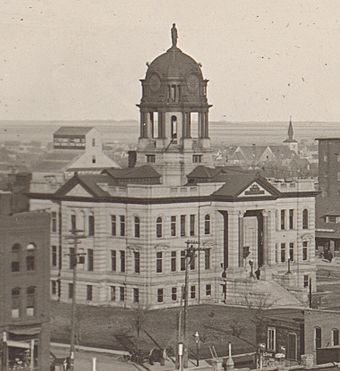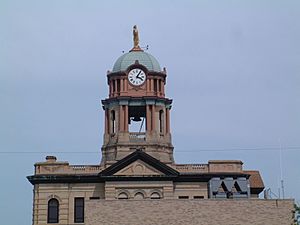Brown County Courthouse (South Dakota) facts for kids
Quick facts for kids |
|
|
Brown County Courthouse
|
|

Courthouse circa 1910, showing original stairway
|
|
| Location | Aberdeen, South Dakota |
|---|---|
| Built | 1904 |
| Architect | Kinney & Detweiler |
| Architectural style | Renaissance Revival |
| NRHP reference No. | 76001718 |
| Added to NRHP | June 3, 1976 |
The Brown County Courthouse is an important historic building in Aberdeen, South Dakota. It's where the local government of Brown County, South Dakota makes decisions. This beautiful building was finished in 1904. It is recognized as a special historic place on the National Register of Historic Places.
Contents
A Look Back: The Courthouse Story
The very first courthouse for Brown County was in Columbia, South Dakota. That was until 1887, when Aberdeen became the main city for the county government.
There was a disagreement about this change. So, the county government briefly moved back to Columbia from 1889 to 1890. But after that, Aberdeen became the permanent county seat. A wooden courthouse was then built in Aberdeen.
Building a New Courthouse
Plans for a brand new courthouse in Aberdeen started around 1902. Two architects, Frank W. Kinney and Menno S. Detweiler, designed it. A builder named E. Miller from Le Mars, Iowa constructed the building.
The new courthouse was completed in 1904. It cost about $120,000, which was a lot of money back then! Some property owners even donated land for the building. The courthouse was officially opened on March 15, 1904. The old wooden courthouse was taken down in 1905. Its site was then turned into a park for everyone to enjoy.
Changes Over Time
In 1974, a big change happened. The original sandstone stairway that led to the second-floor entrance was removed. This was done to make the building easier to access for everyone. A new glass entrance was put in on the first floor.
On June 3, 1976, the courthouse was officially added to the National Register of Historic Places. This means it's a very important building worth preserving. In 2014, the beautiful stained glass window near the old entrance needed repair. It was carefully taken out, cleaned, and put back in place.
Discovering the Courthouse Design
The Brown County Courthouse is a three-story building. It is built in the Renaissance Revival style. This style often looks like grand old European buildings. The courthouse is made from a special stone called Berea Sandstone. This stone came all the way from near Cleveland, Ohio.
Key Features of the Building
The front of the courthouse faces south. It has a grand entrance with two tall columns. These columns are about 20-foot-tall (6.1 m) and are made of granite. The original second-floor entrance has a large, two-story arch. This arch is filled with beautiful stained glass.
On top of the building is a large dome. The dome has four clocks, one facing each direction: north, south, east, and west. At the very top of the dome stands a copper statue of Justice. She represents fairness and law.
The courthouse first stood alone on its block. Later, more offices were added to one corner. A jail was also built at another corner of the building.



